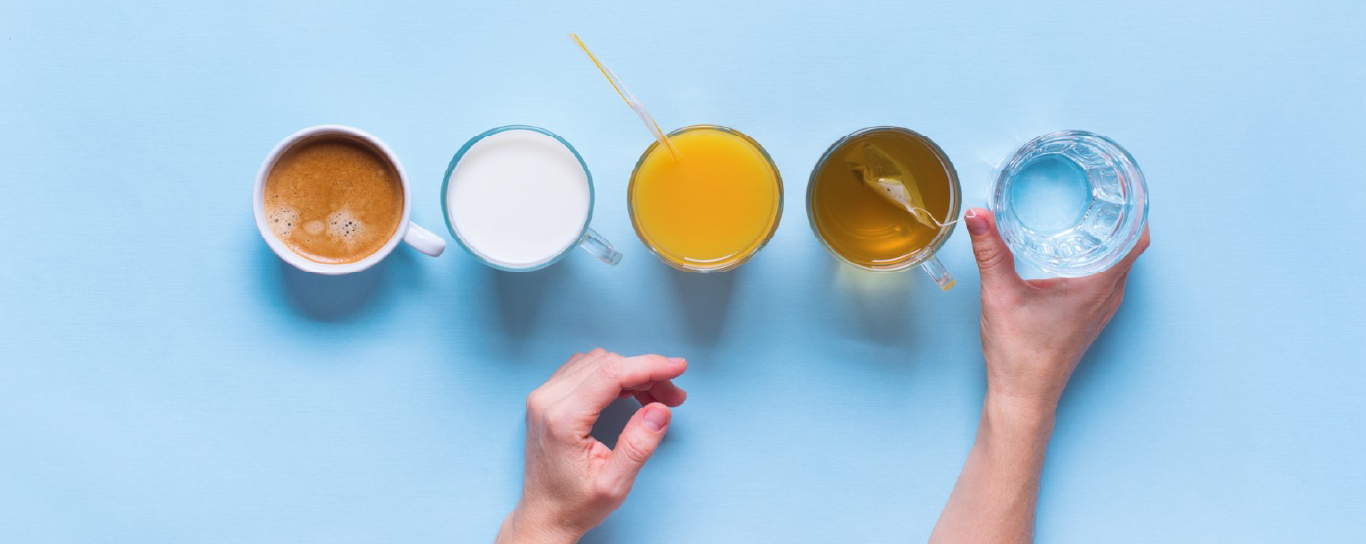
What Counts as Water?
It is not a perfect science, but we have all heard a variation of “drink at least 8 glasses of water per day to ensure you are well hydrated!”
Chances are, you are not drinking enough water. Being under-hydrated affects us in many ways: when we are thirsty, we actually feel hungry and end up reaching for snacks or food! Usually at this point, it means your body is dehydrated.
If you are looking for a healthy way to naturally eat less and feel more energized, drinking an adequate amount of water is critical.
While our daily water content can come from anything that contains water, not all drinks are hydrating or healthy. Below, we review some popular drinks that may or may not be the best thirst quenchers, or may have some other hidden side effects.
Coffee & Tea
Coffee and tea are two of the most popular drinks on the planet. Because a cup of coffee or black tea is mainly water, at low quantities (such as 2 cups per day) it can be hydrating.
At high quantities, caffeine can have diuretic effects. What this means is that caffeine causes your body to make more urine than it normally would, and thus lose water. Drinking too much caffeine in place of water is a risk factor for dehydration.
Not all teas contain caffeine though, so if you are an herbal tea drinker, you are in the clear!
Hydration Tip: Drinking moderate amounts of coffee or caffeinated tea alongside regular water intake will keep you hydrated. Drinking large amounts of caffeinated drinks, such as 5 cups per day or 500 mg of caffeine per day, has been shown to be dehydrating.
Sodas & Other Sugary Drinks
Sugar-sweetened beverages increase your risk of diabetes, heart disease and weight gain.
Although they can contain high water content, sugary drinks actually make you more thirsty because of the high sugar content. When sugar particles enter your blood, they cause water to move out of your cells and into your blood to restore balance. This triggers your brain to sip on something, often leading people to grab another sugary drink, which does not quench thirst!
Fruit Juices
Believe it or not, fruit juice is not the same as eating a whole fruit. Many fruit juices sold in grocery stores are highly processed and have very high amounts of sugar. Even though it is easy to think of it as a ‘natural sugar,’ which therefore must be healthier, this is not the case.
On average, an 8 oz serving of processed fruit juice can contain about 30 grams of sugar. This is almost the same as a 12 oz can of soda, or the equivalent of putting 7 teaspoons of sugar in your cup of tea/ coffee! Moreover, the majority of commercially available fruit juices do not contain the fiber and nutrients found in whole fruits.
Hydration Tip: Many fresh fruits and vegetables contain high amounts of water and are a healthy way to improve daily water intake. Watermelons, for example, are 90% water, and cucumbers are 95% water! If you find drinking water difficult, eating fresh fruit and vegetables can be a healthy alternative.
Staying hydrated is extremely important for your entire body. It is easy to think that because something is high in water content that it must be hydrating, but this is not always the case! Take care to avoid sugary drinks and highly processed fruit juices which may cause you to feel more thirsty than hydrated.
References:
1. Valtin H. (2002). “Drink at least eight glasses of water a day.” Really? Is there scientific evidence for “8 x 8”?. American journal of physiology. Regulatory, integrative and comparative physiology, 283(5), R993–R1004. https://doi.org/10.1152/ajpregu.00365.2002
2. Maughan, R. J., & Griffin, J. (2003). Caffeine ingestion and fluid balance: a review. Journal of human nutrition and dietetics : the official journal of the British Dietetic Association, 16(6), 411–420. https://doi.org/10.1046/j.1365-277x.2003.00477.x
3. Villalobos Cruz, T., Perea Sánchez, J., & Ortega Anta, R. (2015). Fruits and vegetables as important contributors to an adequate hydration status. Nutricion hospitalaria, 32 Suppl 2, 10347. https://doi.org/10.3305/nh.2015.32.sup2.10347
